|
It's that time of year when people within the Science Fiction and Fantasy community are considering which works to nominate or vote for in various important industry awards, such as the Hugo, Nebula, Otherwise, or British Fantasy Society awards. This year, I published two novellas, two short stories, and one non-fiction essay. Whether you are looking for works to consider in these categories, or just looking to catch up with what I've written recently, here they are, along with a brief excerpt to give you a taste! Novella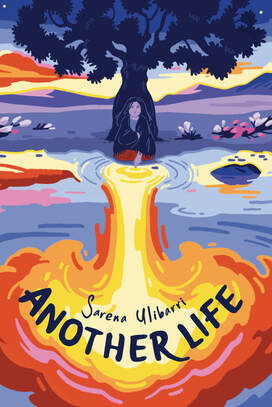 Another Life (Stelliform Press, May 2023) 40,000 words "Otra Vida couldn’t be seen from a distance. By the time you could see the palm fronds or the shade sails, you were practically underneath them. By the time you could tell that the slab of smooth stone between two jagged hills was actually a dam, you could hear the rush of water pouring through it. But approaching now over the rough road at dusk, I could see the glow of soft lights radiating a dome over the basin. The tops of buildings and trees peeked over the rocky ridges. We weren’t quite so hidden as I’d thought. The road followed a canal that snaked through the desert. Solar panels shaded the water to reduce evaporation, and to power the pumping station that moved the water up a rugged incline before it could pour into the basin where Otra Vida and our primary reservoir were located. Between the dam, the panels, and a few strategically placed helix turbines, we generated far more energy than the pumps or the city used." 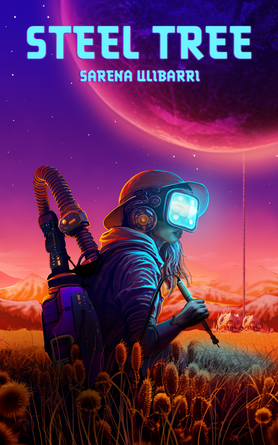 Steel Tree (Android Press, December 2023) 23,000 words Nathan bowed to the fairies and they bowed back. He turned to Fritz and Klara. “They communicate through dance,” he explained. “I believe if I watch them for an hour or so, I can catalog enough of their movements for functional translation.” “What?” Klara asked. “Oh!” Fritz said. “Like bees.” “…what?” Klara repeated. “Bees.” He spoke with a sense of wonder that Klara had never heard from him before. “An insect pollinator from Earth. Bees communicate partially through a type of dance, making complex movements while they fly to signal information to other bees.” “Huh,” Klara said. The universe grew stranger by the moment. She linked her arm with Nathan’s, not wanting to be far from him in this unknown environment, beautiful as it was. “And you think you can understand them.” “I’ve figured out a few phrases already.” “Let’s go watch the show then, and find out what kind of a story we’ve found ourselves in.” Short Story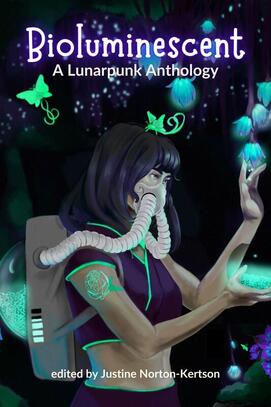 "Sea Shells and Soda Cans" Bioluminescent: A Lunarpunk Anthology (Android Press, January 2023) 5,000 words Flashlight beam sweeping the ground, we left the relatively level strip of old highway and picked our way across the uneven lava rock until the light reflected on calmly sloshing water. Just as I suspected, we were near one of the new lagoons. I shut off the flashlight, and once our eyes adjusted, the water lit up in pale blue and green. It glowed brighter when the water rippled from the kinetic energy of a wave that crashed against the shore farther out. “Whoa,” Kade said, spellbound. “It’s magical.” “It’s plankton,” I said. Warmer waters had actually been favorable to some species of sea creatures, including the plankton and algae that glowed in the nighttime waters like neon lights, especially when they found their way into new, protected pools like this. Kade leaned closer, gazing into the bioluminescent lagoon. Something splashed nearby, and he startled so much he fell over onto his hip, catching himself on the lava rock with one hand. Green eyes flashed in the moonlight, blue sparkles trailing after those eyes before disappearing into the night. 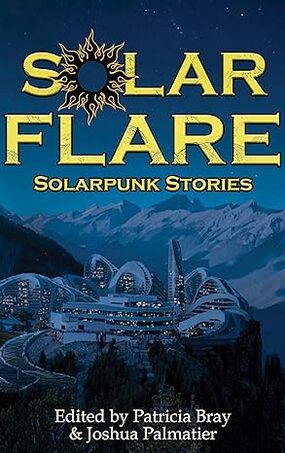 "Walking Through Fog" Solar Flare: Solarpunk Stories (Zombies Need Brains, LLC, July 2023) 3,500 words “Don’t you remember the sandhill cranes?” Malena asks over a dinner of the fragrant soup she’s been craving. I shake my head. “I was a city kid, remember?” “Even in the city,” Malena says, “for a few weeks, every year, they’d pass through. We’d see them anywhere there was a field. I remember spotting them in city parks and high school football fields and golf courses.” Malena and I are nearly the same age, and we’re talking about the same Midwestern city, yet I have no memory of the cranes. I’m startled by this omission. Had these creatures truly flown overhead and grazed in nearby fields without me realizing they were there? How had I managed to make them disappear from my awareness even before they disappeared from the ecosystem? It is a guilt I don’t know what to do with, weighing heavy on me. She goes on to tell me about a road trip her parents took her on when she was very young, to see something called the Festival of the Cranes. “At this revitalized marshland way down in New Mexico, where the cranes would spend the winters,” she says. “You had to get there early in the morning. Even earlier than you like to get up. Hundreds of cranes. Thousands, probably. Snow geese, too. All of them waiting out the night in a shallow lake, and then taking flight at sunrise. People came from everywhere to watch, just to see so many birds, and take pictures.” I find some of those pictures online, the sky so full of birds they nearly block out the sun. Malena rubs her swollen belly affectionately. “I wish we could take our little one to see something like that,” she says sadly. “Maybe this will be the crane’s new nesting grounds after all,” I say. “Winters are warmer, so they won’t have to go so far south.” Malena doesn’t respond and I recognize that expression on her face: a crack of doubt. She’s second-guessing herself, weighing what she knows she saw against the unlikeliness of its reality. Letting her mother’s voice in to tell her she’s been imagining things again. Essay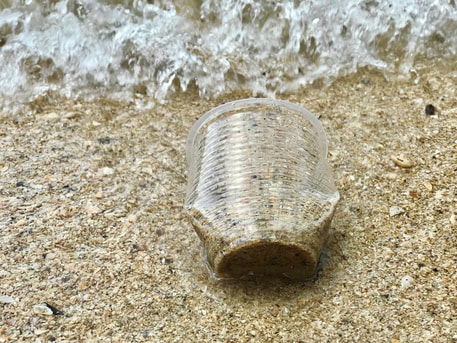 "The Single-Use Soul" (Solarpunk Station, August 2023) "According to “Our World in Data,” approximately 109 billion humans have lived and died in the history of human existence. With nearly 8 billion humans alive right now, that’s 101 billion distinct souls occupying the afterlife. And that number only counts humans—never mind every other sentient being we share the planet with. The idea that souls occupy a human body for (generally) less than a hundred years and then spend eternity in a celestial plane sounds to me like an unbalanced, wasteful system. The single-use soul reminds me of a single-use plastic cup tossed into the landfill as soon as it’s emptied."
0 Comments
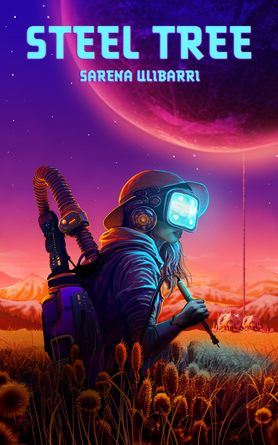 It’s ironic that I’ve published a Christmas book because… I don’t like Christmas. Or at least, I didn’t. For years, I would put my head down and suffer through the season, every festive jingle from retail speakers triggering negative associations. A few years ago, I worked through the roots of that negativity, some of which came from my own life, and some from generational trauma that has trickled down from my grandparents. I decided the best remedy would be to overwrite those negative memories with positive ones. To develop new traditions, rather than hold onto old ones I did not feel connected to. One of those new traditions, for me, has been The Nutcracker. If I saw it as a child, I have no memory of it, but my husband did, and he wants to see it every year. Our compromise was this: I would go with him every year, but we needed to see a different production each year, so the repetition wouldn’t become boring. We’ve seen some creative interpretations, including Nutcracker in the Land of Enchantment, which places the story in New Mexico and replaces the “Spanish Chocolate” ballet segment with authentic Flamenco dancers, and Nutcracker on the Rocks, which retells the story in a modern setting with rock music and hip-hop dance. It was during one of the more traditional shows, though, that I was struck with the idea for Steel Tree. When the inventor Drosselmeyer arrives at the Stahlbaum’s party, he first brings two life-sized dolls that dance stiffly before being carried off-stage. They’re robots, I realized! Or rather, automata, those windup predecessors from the 19th century, like from E.T.A. Hoffmann’s “The Sandman,” which I had read in grad school. As it turns out, the original story of The Nutcracker and Mouse King was also written by E.T.A. Hoffmann, and it is far more bizarre than the (already pretty weird) ballet. I searched for any versions which portrayed the Nutcracker as a robot who awakens to sentience. I found stories like Marissa Meyer’s Cinder, about a cyborg Cinderella, and Claire Legrand’s Winterspell, a dark steampunk take on The Nutcracker, but nothing that quite fit the story that I sketched out after that performance, which I unceremoniously titled “Nutcracker in Space.” Most of the positive memories I have of Christmas take place in Hawai’i. My grandparents lived there, and I was lucky enough to spend several winter breaks trading in a snowsuit for a swimsuit, and decorated pine trees for light-strung palm trees. The last time I visited before my grandmother passed, we toured of several coffee plantations. One of them had a huge processing factory, and the guide explained that smaller farms in the area brought their coffee beans there, and they all got mixed together and packaged under the larger farm’s label. This dynamic struck me as a good conflict for a story, and I held onto it, the way writers collect moments and images and names in a mental drawer like spare buttons. It was a couple of years later that I decided to put these two concepts together. What if instead of coffee, it was nuts, and in addition to the modern factory equipment, the farm had an agricultural android they called a “nutcracker”? The final piece that brought this story to life was Elon Musk’s absurd plan to offer “loans” to people who can’t afford to go to Mars, which would be worked off once they were on the red planet—a system that is indentured servitude in everything but name. These three ideas coalesced to become Steel Tree. Klara is one of those indentured servants—not on Mars, but on a pair of fictional double planets: Eta (named after E.T.A. Hoffmann, of course), and Petipa (named after Marius Petipa, the choreographer who first adapted The Nutcracker into a ballet). Klara runs the factory where the farmers bring their harvest, and the nutcracker androids package everything to be sent from Eta to Petipa—an arrangement that some think privileges Klara’s family over the rest of the farmers. In the ballet, her brother Fritz accidentally breaks the Nutcracker by playing too rough; in my version, her neighbor Fritz sabotages one of the nutcracker androids, accidentally causing the robot to “wake up” and gain self-awareness. I placed each of the familiar elements into this science fictional setting, borrowing from the structure of both the ballet and Hoffmann’s original, adding plenty of embellishments of my own. I hope that, whether you love or loathe the holidays, Steel Tree can bring a fresh perspective to an old tradition. Find Your Copy:Finding out who you were in a previous life sounds like fun until you’re forced to grapple with the darkness of the past. Galacia Aguirre is Mediator of Otra Vida, a quasi-utopian city on the shores of a human-made lake in Death Valley. She resolves conflicts within their sustainable money-free society, and keeps the outside world from meddling in their affairs. When a scientific method of uncovering past lives emerges, Galacia learns she’s the reincarnation of Thomas Ramsey, leader of the Planet B movement, who eschewed fixing climate change in favor of colonizing another planet. Learning her reincarnation result shakes the foundations of Galacia’s identity and her position as Mediator, threatening to undermine the good she’s done in this lifetime. Fearing a backlash, she keeps the results secret while dealing with her political rival for Mediator, and outsiders who blame Otra Vida for bombings that Galacia is sure they had nothing to do with. But under the unforgiving sun of Death Valley, secrets have a way of coming to light. ANOTHER LIFE is a solarpunk science fiction novella by Sarena Ulibarri, available now from Stelliform Press! “The sparse but evocative worldbuilding of Ulibarri’s brilliant solarpunk debut underpins a guarded optimism about the human condition…grounded in quiet interpersonal dynamics and a thought-provoking exploration of how the past should inform the future. With an incisive exploration of postcapitalist, back to basics living and characters readers will root for, this perfectly balances big ideas and big emotions.” Buy a Copy:  Sarena Ulibarri is a fiction writer from the American Southwest. Her short fiction has been published in DreamForge, GigaNotoSaurus, Lightspeed, Solarpunk Magazine, and elsewhere, and you can find her non-fiction essays about climate fiction in Strange Horizons and Grist. As an anthologist, she curated two international volumes of optimistic climate fiction, titled Glass and Gardens: Solarpunk Summers and Glass and Gardens: Solarpunk Winters, and also co-edited Multispecies Cities: Solarpunk Urban Futures. Finding out who you were in a previous life sounds like fun until you’re forced to grapple with the darkness of the past. Galacia Aguirre is Mediator of Otra Vida, a quasi-utopian city on the shores of a human-made lake in Death Valley. She resolves conflicts within their sustainable money-free society, and keeps the outside world from meddling in their affairs. When a scientific method of uncovering past lives emerges, Galacia learns she’s the reincarnation of Thomas Ramsey, leader of the Planet B movement, who eschewed fixing climate change in favor of colonizing another planet. Learning her reincarnation result shakes the foundations of Galacia’s identity and her position as Mediator, threatening to undermine the good she’s done in this lifetime. Fearing a backlash, she keeps the results secret while dealing with her political rival for Mediator, and outsiders who blame Otra Vida for bombings that Galacia is sure they had nothing to do with. But under the unforgiving sun of Death Valley, secrets have a way of coming to light. Another Life will be published by Stelliform Press in May 2023. You can preorder your copy direct from the publisher right now! If you prefer to purchase from Amazon, Barnes & Noble, or another bookseller, check back and I'll share those links as soon as they're available.
This year has been a hell of a decade, right? I published three short stories this year, plus one non-fiction essay. On the off-chance that you feel inspired to nominate my work, or the stories in the anthology I edited, for whatever awards or lists you might be nominating for, here's the list of my 2020 accomplishments. 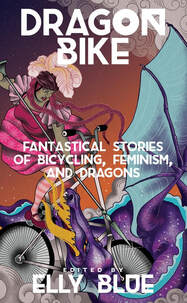 "The Dragon's Lake" published in Dragon Bike: Fantastical Stories of Bicycling, Feminism, and Dragons, February 2020 "…a fresh take on epic fantasy, complete with giant snails." "The Dragon's Lake" is about a novice adventurer who gets separated from her adventuring party and trapped by a dragon-centered cult policed by giant snails. There's no white knight to charge in and save this protagonist; she has to work together with another woman who's trapped to figure out a way to escape. (Hint: their plan includes a bicycle.) 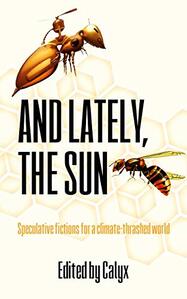 "Inviting Disaster" published in And Lately, The Sun, November 2020 A teen in tornado-ravaged Kansas, where houses can now retract underground to safety, falls in love with a new neighbor who constantly flirts with danger. See a brief video of me reading an excerpt from this story at https://latelythesun.com/2020/11/25/inviting-disaster-by-sarena-ulibarri/ 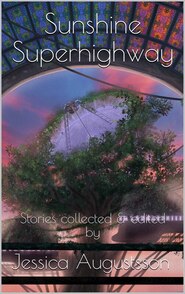 "All My Eggplants in One Basket" published in Sunshine Superhighway, December 2020 "All My Eggplants in One Basket" is about a rooftop gardener and the pterosaur who moves into her garden plot. It also features an island paradise that's not just for the rich, a sneaky protester, and a lot of Art Nouveau imagery.  "What Do We Do When the World Doesn't End?" published in Strange Horizons, March 2020 A personal essay about solarpunk, my hippie parents, and how I coped with the COVID-19 pandemic by trying to learn how to garden. 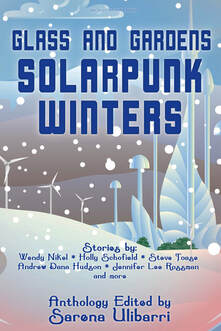 Glass and Gardens: Solarpunk Winters, published by World Weaver Press, January 2020 I'm not actually eligible for any of the "Best Editor" awards, but all of the stories in this anthology are eligible in either the short story or novelette categories, and I would celebrate their nomination as much as my own. This anthology envisions winters of the future, with stories of scientists working together to protect narwhals from an oil spill, to bring snow back to the mountains of Maine, to preserve ecosystems—even if they have to be under glass domes. They're stories of regular people rising to extraordinary circumstances to survive extreme winter weather, to fix a threat to their community's energy source, to save a living city from a deep-rooted sickness. Some stories take place after an environmental catastrophe, with luxury resorts and military bases and mafia strongholds transformed into sustainable communes; others rethink the way we could organize cities, using skybridges and seascrapers and constructed islands to adapt to the changes of the Anthropocene. Even when the nights are long, the future is bright in these seventeen diverse tales. If you want to keep up with what I'm doing, the best way is to subscribe to my newsletter. And did you know I have a pen name? An actual full-length book, and maybe more, will be coming out under that name in 2021.
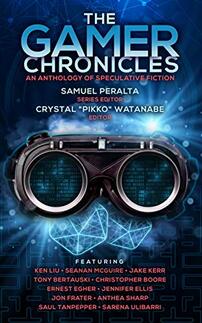
Samuel Peralta's "Future Chronicles" anthologies are always fantastic collections, and I was thrilled to be invited to participate in this one, especially after I leaned I would be sharing a table of contents with authors such as Ken Liu, Seanan McGuire, and Jake Kerr. It's actually my second one with Jake—we were in the same issue of Lightspeed years ago. I've never been much of a video gamer, but I've long been obsessed with virtual reality, and that's the type of game I wrote about in "Sick and Tired."
In a world of nearly instant cures and ubiquitous good health, Sick and Tired Disease Simulation Agency offers virtual reality games that allow people to experience illness without the physical toll. After Jacob’s easy, fifteen-minute procedure zaps his cancer away, he becomes obsessed with the blog his grandmother wrote while dying of the same affliction fifty years before, and decides to visit Sick and Tired to understand what he was spared from. But the deeper Jacob gets into the game, the looser his grip becomes on which of these realities is true and which is illusion. I think eventually this will be available in print, but right now you can only get it in ebook. It's been a very popular ebook, though We even spent some time as a #1 New Release in Science Fiction Anthologies! Get the book here:My solarpunk western story "The Spiral Ranch" is part of the Founders Issue of DreamForge Magazine, a new pro-level science fiction and fantasy market devoted to optimistic speculative fiction. They even commissioned original illustrations for my story! DreamForge launches on February 14, 2019, and they're currently running a Kickstarter to fund their next several issues. The Founders Issue also includes new stories from Steven Brust, Jane Lindskold, Lauren C. Teffeau, and more. About the StoryMy story, "The Spiral Ranch," is a science fiction western that takes place in a futuristic Austin, TX. In order to combat climate change, massive swaths of agricultural land were replaced with Carbon Sequestration Forests, and food production shifted into cities. Vertical farms grow produce, and the Spiral Ranch is a pasture within a skyscraper, housing several herds of cattle for dairy and meat. And one day, the cattle start disappearing… It's based on a bit of bizarre conceptual architecture called the "Circular Symbiosis Tower" that applies the idea of vertical farming to livestock. Check it out here. About DreamForge"At DreamForge, we are about hope in an age of dystopia. Our goal is to encourage the abandonment of the dystopian mindset and promote the ascendency of reason and humane values, civility, community, and scientific advancement. We see the human challenge through an optimistic lens."
 I enjoyed the film Halloween (2018) far more than I expected to, but one aspect of it continued to bother me after I left the theater: the film’s focus on guns. Many films and TV shows use guns, but they're usually either just props/tools, or they're presented as glorified extensions of the action hero. Something about this presentation felt different than either of those. “It’s kind of NRA propaganda,” I joked to my husband on the drive home, and we talked about how Laurie was a model conservative, using guns to protect her family and fighting back against the faceless government man—referring to the fact that the doctor calls Michael Myers “property of the state.” I’ve read a couple of articles that claim this film as an affirmation of right-wing, pro-gun values. And honestly, sure, the film can be interpreted that way. There are even a few ancillary details that support that reading. But I think the film’s focus on guns is actually doing something much more subtle and interesting. The reason that both the original 1978 Halloween and the 2018 Halloween films are so successful is because they both acutely synthesize the horrors of their historical moment. And the contextual horror relevant to the 2018 Halloween is actually not the political divide. Not directly, anyway. Let’s go back to the 1978 Halloween for a moment, and consider what was happening in America in the 1970s that made films like Halloween and Friday the 13th resonate so strongly with viewers: serial killers. Ted Bundy and John Wayne Gacy each killed more than 30 victims between approximately 1972 and 1978. They weren't the first serial killers in America, but they were some of the worst, and they killed mostly teens and young adults. Michael Myers is not a direct analog to either one of these real life killers, but “The Shape” represents not a single real-life serial killer, but the idea of serial killers in general, and the fear that was gripping the country in the 1970s that this type of evil could strike anywhere, at any time. 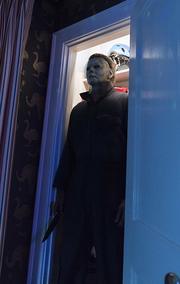 [TW: rape] But we know that serial killers like Bundy and Gacy did not only kill their victims, they also sexually assaulted them. Bundy, in fact, reportedly claimed that rape was his initial goal, and murder was a convenient way to keep from getting caught; it was only after several victims that murder became the goal. But Halloween’s Michael Myers is not a sexual predator. In fact, he appears to be punishing the promiscuity of teenagers. The fact that the sex in Halloween is consensual has the side effect of shifting blame onto the victim in conventional rape-culture style. And because we need stories to make more sense than real life, it also creates a rationalization for these characters’ death, becoming a warning in the way that fairy tales are warnings: Don’t go into the woods alone, or Baba Yaga will eat you. Don’t walk down by the river, or La Llorona will get you. Don’t screw around with your boyfriend while you’re supposed to be babysitting, or Michael Myers will get you. He’s the Boogeyman, right? It’s certainly an imperfect system, though, since the virginal Laurie Strode still gets attacked. I argue that the common horror film trope of “death by sex,” in which fornicating teenagers are then subsequently killed, is a way for filmmakers to associate sex with murder, thereby depicting a metaphorical rape, rather than a literal one. Let’s shift back to the 2018 Halloween now. Note that there is actually no sex in this film. We still have a couple of teenagers messing around while they’re supposed to be babysitting, but they never get naked. And while Michael Myers has a higher body count in this film, the victims are far more random, varying in gender and age. Is this just an arbitrary narrative choice, or an attempt to avoid a trope that has become a cliché? Or is it an intentional choice that creates a very different sort of metaphor than the original? (And, yes, I’m aware that several of his victims mirror victims from the other now non-canonical Halloween films. That doesn’t affect my theory.) Serial killers still exist, for sure, but there hasn’t been one that has really gripped the American public imagination for a couple of decades now. But what type of senseless violence do we deal with in the 2010s? What creates that fear of “it could happen anywhere at any time” now? What’s in the news every couple of days? 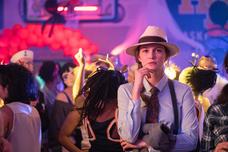 Mass shootings. The guns in Halloween 2018 aren’t just in Laurie Strode’s prepper-style compound. They’re everywhere in the film, in the hands of many different characters. During their walk to school, the kids talk about how “by today’s standards” the fact that Michael Myers killed five people doesn’t really sound that awful. One of our first bodies in this film is a kid who would rather be at dance class than out hunting, who accidentally shoots the doctor who has survived the bus crash. Even Allyson and her boyfriend choosing to dress as (gender-swapped) Bonnie and Clyde evokes the idea of gun violence, as does the bizarre prediction by Allyson’s father that she’ll grow up to “get fat and clean guns.” In the same way that the 1978 film portrays consensual sex as a way to depict a metaphorical rape, I argue that the 2018 Halloween’s focus on guns creates a similar subconscious association as a way to invoke metaphorical gun violence. By depicting consensual sex in the original, the association between death and sex becomes more palatable. The oblique angle allows viewers to grapple with the real life horrors of what happens to serial killers’ victims without facing it directly. By putting the guns in the hands of heroes and victims, rather than in the hands of the killer, it complicates the issue and prevents the knee-jerk reaction many viewers would certainly have if mass shootings were being portrayed directly. In the same way that “The Shape” represented the threat posed by serial killers in the 1970s, “The Shape” represents the threat posed by mass shooters in the 2010s. 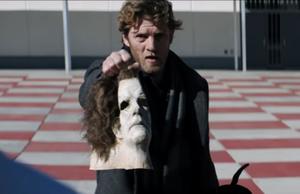 This interpretation also helps to make sense of the useless “podcasters” who show up at the very beginning. These characters serve very little purpose to the actual plot—sure, we get some exposition from them, but it’s nothing that the filmmakers couldn’t have revealed through interactions between other characters. But every time a mass shooting happens, it’s the media that holds up the killers’ faces to us and demands we say something about it. That scene at the very beginning, when the journalist holds up Michael’s mask to him and yells at him to say something is utter abelist nonsense if I try to think about it literally, but as part of this metaphorical interpretation, it fits perfectly. Consider also the kid who gets “friend-zoned” by Allyson (Laurie’s granddaughter). There were a lot of different ways the filmmakers could have gotten Allyson separated from the pack, so to speak, but they chose to do it by having her walk away from a boy who tried to kiss her against her will. This kid then proceeds to have a several minute long (one-sided) conversation with a lurking Michael Myers, asking if he’s ever wanted a girl he couldn’t have. The lamentations of this character echo the motivations of several recent shooters, who had been rejected by a girl and retaliated by going after her with a gun, also shooting anyone who got in his way. Really, although Michael seems not to care who he kills, ultimately he is going after Laurie, “the one who got away,” and many of his other victims are incidental on his quest to get her. 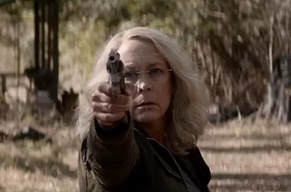 So what, then, does Halloween 2018 say about gun violence? Is it, as some of the right-wing bloggers have claimed, supporting that belief that the only way to stop a bad guy with a gun is a good guy with a gun? I’m not sure it’s that simple. Horror may provide warnings, but it doesn’t necessarily offer solutions. The central theme of the film is that one monster has created another monster. It’s also very much about the power the victimizer continues to hold over the victim even many years after the trauma, and the way cycles of trauma repeat themselves over generations. Laurie’s obsession with Michael, the numerous role reversals and homages to the original, and the fact that she’s hunting him as much as he’s hunting her remind me of what sometimes happens with people who start to carry guns: they start looking for, hoping for, the chance to use them. (And studies have shown that violent crime actually increases in states with conceal carry laws, by the way.) Laurie even says at one point that she’s been praying for Michael to escape so that she has the chance to kill him. Though Myers gets shot multiple times, it’s not actually the guns that finish him off. And he can’t truly be killed anyway. “The Shape” may change, but the evil he represents will likely always be with us. From January 1, 2019 to March 1, 2019, I will be accepting submissions for an anthology of optimistic science fiction stories set in winter—specifically, solarpunk stories, which means stories that engage with climate change, renewable energies, or other environmental issues through an optimistic lens. This will be a followup to my anthology Glass and Gardens: Solarpunk Summers, which took the same approach for stories set in summer. To break it down, the story must be:
Beyond those criteria, I'm open to a wide range of interpretations of the prompt. The Solarpunk Summers anthology was quite varied, and I want this one to be as well. If you have an idea that might fit, then I hope you'll let me see it, However, if you want some insight into specifically what I'm looking for, or need some prompts to get rolling with an idea, check out my wish list below. To submit a story to Glass and Gardens: Solarpunk Winters, send it as an attachment, with a brief cover letter in the body of the email, to solarpunk[at]worldweaverpress[dot]com. Stories up to 8,000 words will be considered, and we will pay $0.01 per word. Please submit only between January 1 and March 1, 2019 unless an extension has been posted on the World Weaver Press website and social media. The full guidelines may be found here: www.worldweaverpress.com/submit-anthologies.html Migration A couple of my cousins recently decided to sell their home, quit their jobs, homeschool their kids, and travel the country in their RV full time, working a few seasonal jobs to support themselves. They made this radical lifestyle change because they recognized the absurdity of working long hours at a job you hate to pay for a house you hardly stay in and to support a family you never see. This strikes me as a very solarpunk thing to do (though it would be more so if the RV were fully electric), and possibly even a precursor to the "walkaway" culture depicted in Cory Doctorow's cyberpunk/solarpunk novel. Imagine a world where this kind of migratory lifestyle was more common, perhaps even necessary, where cities are uprooted and the roads become the real communities. Imagine fleets of solar-powered RVs, caravans sharing a portable wind turbine, highways built to both maximize travel and minimize damage to the land and wildlife. That's one type of migration, but maybe in a solarpunk future people will migrate the way animals do, going north in the summer to escape intense heat and south in the summer to escape extreme cold. (Or vice versa for the southern hemisphere.) What can we learn about the migration patterns of animals that can make our own living circumstances more adaptable to the changing planet? Consider also the Kasita concept: a "portable, stackable studio apartment" that can be slid out of its apartment "rack" and moved as a whole to a different "rack" in a different location. (See what I'm babbling about here.) Who might live in this kind of a place, and where would they be moving to? Snow Sometimes people assume that "global warming" will mean there is no more snow and ice, but in some locations, it's likely to have the opposite effect, leading to more extreme blizzards. Higher global temperatures mean more water vapor in the air, which can lead to heavier snowfall. Warmer lakes may not freeze as early as they used to, leading to more lake effect snow as cold air blows across their surface. The loss of arctic sea ice may actually be making winters longer, because of the weakening of the polar vortex that used to keep arctic air trapped northwards. So do your research about what the future of winter might actually look like. I don't need every story to look like a snow globe, but I will look skeptically at ones that just assume snow is a thing of the past. Wet Season/Dry Season I'm well aware that many places in the world don't have "winter" and "summer" per se, but rather a wet season and a dry season, and the timing of those seasons varies immensely depending on the local climate. I'm interested in seeing interpretations of "winter" that correspond to local climates and investigate the unique challenges those particular locations will face under climate change. If your story is set in the northern hemisphere between November and March, or in the southern hemisphere between May and September, and the weather or climate plays a role in your story, then that counts as winter as far as I'm concerned. Winter Holidays I'm open to a solarpunk Christmas story—maybe something that addresses a more sustainable way of harvesting/disposing of Christmas trees?—or a solarpunk Hanukkah story—maybe a retelling about a solar array that should only be enough to power one city block, yet powers eight?—but I'm also very interested in stories that feature any or all the other winter holidays: Yule, Diwali, Kwanzaa, Chinese New Year, Shab-e Yalda, etc. The world is large, and there are many festivals that celebrate light in the darkest time of the year. Or perhaps your solarpunk society will create a new winter holiday? Geothermal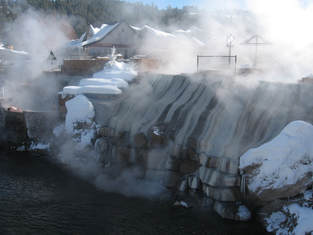 When I think of solarpunk winters, I picture places like Pagosa Springs, a Colorado mountain town where food is grown year-round in geodesic domes that are heated by the same geothermal hot springs that allow you to float in 100 degree pools while snow falls around you. How can we safely and sustainably harness the Earth's own heat to keep ourselves warm? What kind of a story might take place in a futuristic wintry hot springs? AntarcticaI saw a climate change map recently which predicted that when the world is 4 degrees warmer, the ice on Western Antarctica will be completely melted and that land will be covered in large cities. Similar ideas were proposed way back in the early 20th century, imagining domed cities in Antarctica. Either of these seems like a fascinating setting for a solarpunk story. What are cities like in a future Antarctica? And even if conditions are pleasant during the summer, how do the people there deal with the long nights of winter? Then, of course, there's the issue of what gets revealed when the ice melts. Cities of ancient monsters (a la At the Mountains of Madness); buried alien ships (a la The Thing); the lost city of Atlantis. All of these ideas have been done before, but you can put a fresh spin on them by considering them through a solarpunk lens. Indigenous Futurism 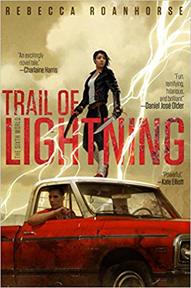 In Trail of Lightning by Rebecca Roanhorse, energy wars leave the country vulnerable and a massive earthquake splits the continent in half, but this apocalypse is actually a rebirth for the Navajo Nation in New Mexico and Arizona, partly because they wall themselves in, partly because they already know how to survive without modern conveniences, and partly because "the Diné had already suffered their apocalypse over a century before." In Binti by Nnedi Okorafor, a Himba girl's desire to go to space clashes with her duties to her family and her tribe's culture, but it's that very culture that makes her the best person to negotiate with the aliens who attack her spaceship. In "Xibalba Dreams of the West," Brazilian author André S. Silva imagines the Americas as a network of high tech and sustainable Indigenous societies that were never colonized by Europe, and who are now confronting the end of the Mayan calendar. Indigenous futurisms often show typical science fiction tropes through the lens of traditional beliefs and folklores, and push back against the colonialism that sci-fi often just takes for granted. Indigenous futurism, Afrofuturism, and other similar movements center the experiences of people of color and bring fresh perspectives to a genre that can sometimes tend toward homogeneous or white-washed views of the future. I would love to see some of these perspectives in the Solarpunk Winters slush pile. If your story references a particular cultural practice or traditional story, please feel free to mention that in the cover letter so I can consider it within the correct context. QueernessOne of the few negative reviews that Glass and Gardens: Solarpunk Summers received said that in some of the stories, "homosexuality felt thrown into the story, not to benefit the story or enhance the character, but more, it seemed, as a cheap ploy to get more people to read." In another location, this same reviewer rants for an entire paragraph about why bisexuality shouldn't even be mentioned if the female character ends up with a "guy" instead of a "woman." In the story being referenced there, the character actually ends up with a nonbinary person, but that was clearly so far beyond the reader's comprehension they couldn't even process it. I'm fairly certain this reader gave up on the book in the middle of another story that featured a nonbinary character with zie/zir pronouns. I hold strong to the belief that queer characters can simply exist in a story without being there as a teaching tool for cishet readers or as some kind of metaphor. A story doesn't have to be about queerness to include queer characters. Queerness in science fiction can "benefit the story" simply by depicting a future where queer people can live lives not entirely defined by their queerness, where they are not marginalized or presented as "other". A solarpunk future, especially, must be inclusive, and mentioning a character's bisexuality or transness just as a passing fact can help normalize queerness for readers and lead us toward that more inclusive future. I'm proud of the subtle queerness of Solarpunk Summers (which, incidentally, I never tried to use as a marketing angle), and I'd like to repeat that in Solarpunk Winters. I'm fine with the depiction of cishet characters and relationships as well--Solarpunk Summers featured a number of them. It's not a romance anthology, so I don't explicitly need to know the preferences of all of your characters. But please do feel free to send me stories with gay characters, trans characters, asexual characters, characters who use neo pronouns, etc., and let these characters be as overt or as subtle about those queer traits as the story demands. Additional Recommended Resources
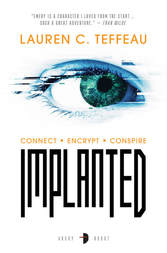
This book was originally being marketed as cyberpunk, but the publishers, Angry Robot, switched over to calling it solarpunk just a couple of weeks before release. It is definitely both: it has the cyberpunk technology of the neural implant, which is sort of like an instant messenger in your brain, controlled by eye movements, that also allows you to feel the emotions of the people you're connected to. It also has the fast-paced race-against-the-clock feel of cyberpunk, and the focus on information and data as the ultimate key to power. To keep sensitive data from being hacked, they encrypt it into a courier's blood cells. So, yeah, it's totally cyberpunk.
But Implanted doesn't take place in the same dark, polluted, brutalist type of setting usually featured in cyberpunk. New Worth is a domed city—one of many that people have retreated into to survive a massive climate crash. The city itself is stratified, based on the anatomy of a forest: the rich live up in the Canopy or the Echelon, the middle class in the Understory, etc. Many of the descriptions we get of the city show it as green, beautiful, with plants and fountains and attempts to simulate the nature they're yearning to get back to. Much of the plot revolves around the idea of Emergence from the dome—when it will happen, who does the work, who gets to benefit. New Worth is certainly not a utopia, but it's not a straightforward dystopia either, and our narrator learns there's a lot more going on than she realized at both the highest and lowest levels of this complex society. It's ultimately very optimistic and "punk" in unexpected ways. So, yeah, it's totally solarpunk. Here's the official description: When college student Emery Driscoll is blackmailed into being a courier for a clandestine organisation, she's cut off from the neural implant community which binds the domed city of New Worth together. Her new employers exploit her rare condition which allows her to carry encoded data in her blood, and train her to transport secrets throughout the troubled city. New Worth is on the brink of Emergence - freedom from the dome - but not everyone wants to leave. Then a data drop goes bad, and Emery is caught between factions: those who want her blood, and those who just want her dead.
Lauren C. Teffeau is a fellow New Mexico writer, and I read pieces of this book in a much earlier draft. I loved it back then, but I was blown away with how tight and exciting the story became in this final version. I asked Lauren to chat with me about her path to publication and her approach to worldbuilding. 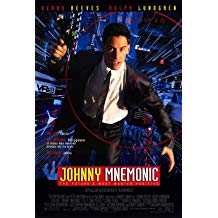
Sarena Ulibarri: In a nutshell, what was the path from manuscript to publication for IMPLANTED?
Lauren C. Teffeau: Some of my projects have longer gestation periods than others. I was building the world IMPLANTED is set in well before I had an agent or a professional sale under my belt, so we’re talking many years here. I like to think that time was crucial in thinking through all the moving pieces and bringing it to life in vivid detail. We’ll see! I went through many drafts with my crit groups until I felt like I had a strong enough project to bring to my agent. I revised it again based on her feedback, and the manuscript sold to Angry Robot after approximately six months on submission. SU: The early drafts of IMPLANTED were written as Young Adult, but it’s being published now as Adult. What changes did you need to make to “age it up” in the final version? LCT: This is an issue I have run into before with my novel projects. I’m drawn to that time in characters’ lives when they face their “first test” in the real world. While that’s often part and parcel of coming-of-age stories which we often see in YA, I seem to always come up with scenarios where it’s harder to justify how these young teens are doing all these amazing things to save the world on such a grand scale, when it’s far more realistic for someone a bit older to have the life experience and, more importantly, the access necessary to drive the plot. Plus as a recovering romance writer, I sometimes include adult themes in my stories that are more appropriate for Adult books. As far as IMPLANTED goes, when my agent and I decided to treat it as an Adult project, it actually made some of the setup a lot easier to pull off because I didn’t have to explain all the reasons why my teenaged main character had the skills/background needed to make her role in the story more convincing. Instead of being a high school student, she’s now a recent college grad and has four more years under her belt to contribute to suspending readers’ disbelief. SU: Could you talk a little about the worldbuilding of New Worth? What tools did you use to imagine and create this fascinating domed city? LCT: I wanted to explore what happens after the coming climate apocalypse, a time where people have had to retreat from the natural world. The traumatic upheaval would be felt for generations and affect the city’s design and development as living memory fades and approximations and reinterpretations become all that’s left over. In a domed city where people are kept at far remove from nature, I figured access to the sun would become a new commodity of sorts. That led me to modeling my city’s structure off of the rainforest: canopy, understory, and ground level, each distinct ecosystem defined in part by the amount of sunlight they receive. And in my domed city of New Worth, those sections roughly correspond to different socio-economic groups, with the rich and well-connected living in the upper levels with the most access to sunlight. Population ecology, survivor bias, even fractals all contributed in some way to the city’s design as well. SU: What books, authors, or films influenced you while writing IMPLANTED? LCT: When I’m drafting, I try to keep my mind uncluttered of other media until the story I’m trying to write has firmed up and can stand on its own. That said, I’ve always loved espionage-tinged media—James Bond, Jason Bourne, even Sterling Archer—romance, YA, and most action/adventure properties, and those interests often come out in my work in both subconscious and conscious ways. At some point I was descripting IMPLANTED thusly: Take Johnny Mnemonic, add a dash of Person of Interest, mix with Logan’s Run, and wrap it all up in a Blade Runner-meets-solarpunk aesthetic. SU: What advice do you have for beginning writers who are struggling through the first draft of a science fiction novel? LCT: Finish your shit. And it will feel like shit. It will feel like you’re a fool for wanting to write and for wanting to share your stories with the world. But you have to push through all that to get to THE END. Then, take a break. When you return to your project, you’ll discover that maybe it isn’t as bad as you thought it was. Or that you are in a better position to see the story’s flaws and how to fix them. Either way, you cannot submit something that is incomplete. And it is only once a draft is complete that you can get a sense for how to revise. If nothing else, remember there are no shortcuts and try to enjoy the journey along the way. SU: Do you have any readings or signings coming up? Where can readers find you? LCT: August 3-5 ArmadilloCon in Austin, Texas August 10 Reading and Q&A at the Albuquerque Science Fiction Society August 16-19 Worldcon in San Jose, California August 24-26 Bubonicon in Albuquerque, New Mexico September 6 Reddit/Fantasy Ask Me Anything September 8 Reading and Signing at the Denver Science Fiction and Fantasy Series September 15 Reading and Signing at Page1 Books Albuquerque, New Mexico October 7 Reading and Signing at Bookworks Albuquerque, New Mexico October 19-21 MileHiCon in Denver, Colorado My website laurencteffeau.com is the best way to stay up-to-date with what’s going on with me. 
Lauren C. Teffeau was born and raised on the East Coast, educated in the South, employed in the Midwest, and now lives and dreams in the Southwest. When she was younger, she poked around in the back of wardrobes, tried to walk through mirrors, and always kept an eye out for secret passages, fairy rings, and messages from aliens. She was disappointed. Now, she writes to cope with her ordinary existence. Follow her on Twitter, Goodreads, Amazon.com, and Pinterest.
|
Archives
January 2024
Categories
All
|
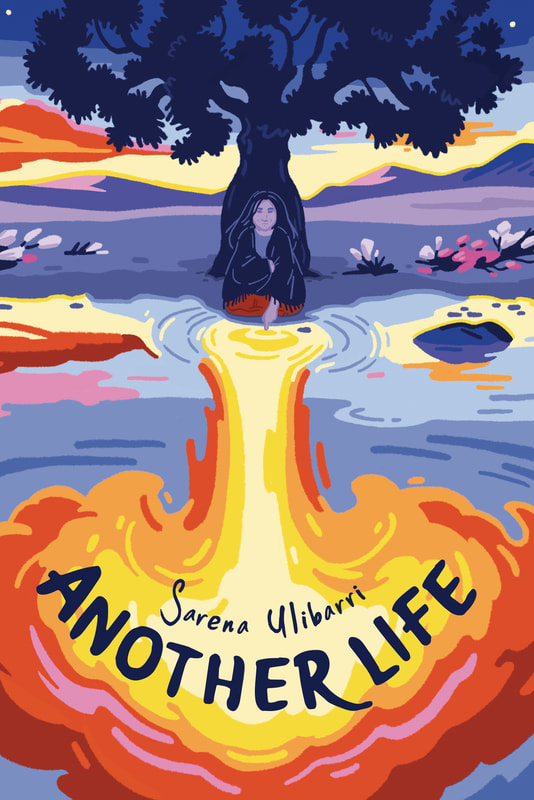
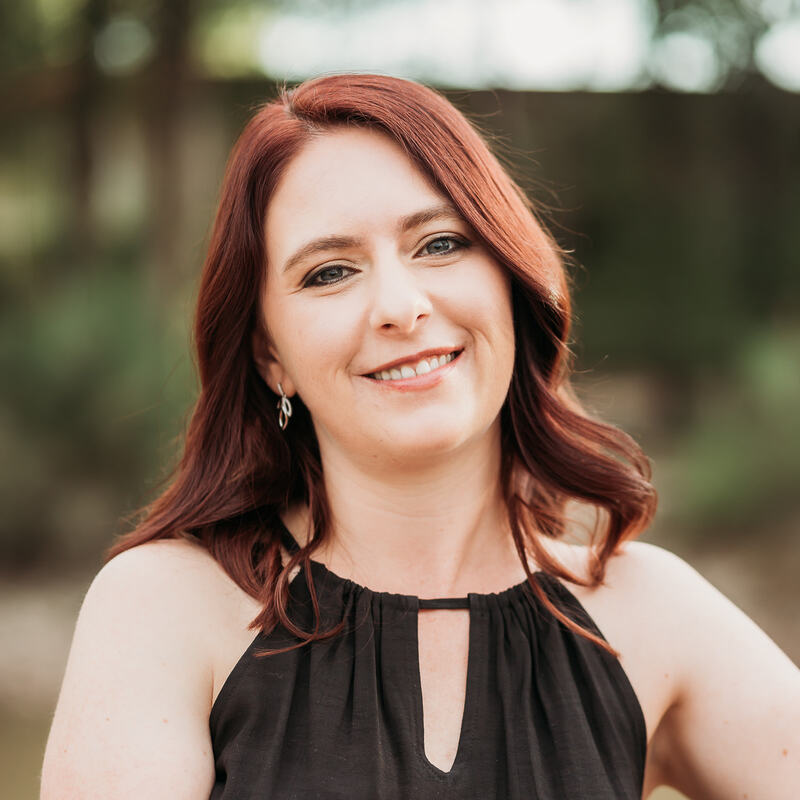
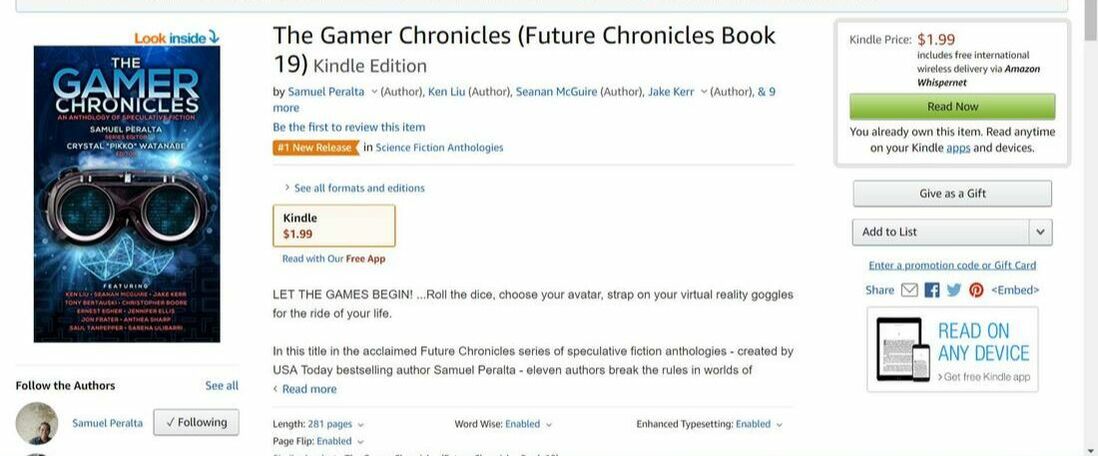

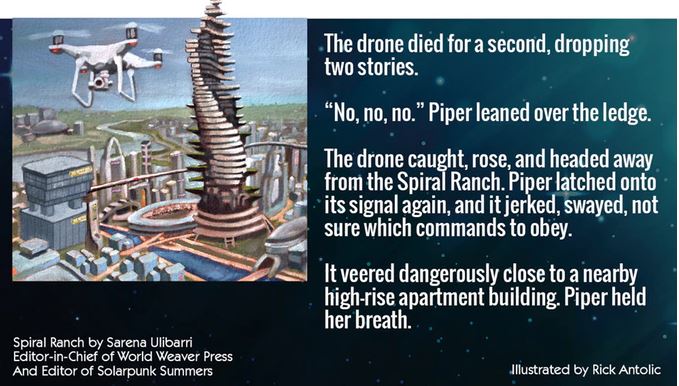

 RSS Feed
RSS Feed